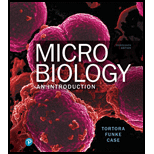
To write:
The complement destruction of the pathogenic organisms.
Given:
“Successful
Introduction:
The complement system consists of thirty heat-labile proteins from plasma, which involves the opsonization of pathogens for assisting the immune responses of the host. The complement proteins are protease in nature, which helps to cleave the antigens to neutralize the infectious substances. It is a cascade or a series of proteins (from C1 to C9 and some proteins are indicated as lower cases a and b) that commence at the time of infection which is termed as complement activation.
The proteins from the complement system play a major role in the destruction of microbes by inflammation, cytolysis and opsonization. It is an essential barrier that protects the host tissue from the invading organisms.
Want to see the full answer?
Check out a sample textbook solution
Chapter 16 Solutions
Microbiology: An Introduction (13th Edition)
- The figure below shows antibodies bound to repetitive epitopes on the surface of a bacterial pathogen. Even though all of these epitopes are identical, not all of them have antibodies bound to them. The most likely explanation for this failure of antibodies to bind to every possible epitope on the surface of the pathogen is: There is an insufficient amount of antibody to saturate all the epitopes. The pathogen has an immune evasion strategy to avoid antibody binding to all epitopes. Some of the epitopes cannot bind antibody due to steric hindrance. The antibodies are only able to bind when both antigen-binding sites are engaged on the pathogen surface. The epitopes on the pathogen are not all in the same conformation, so not all will bind the same antibody.arrow_forwardWhich of the following contribute to a pathogen's invasiveness? endotoxins hyaluronidase F proteinarrow_forwardAll of the following are methods intracellular pathogens can use to survive inside a host cell EXCEPT create a capsule. Escape the phagosome. survive in the phagolysosome. prevent phagosome-lysosome fusion.arrow_forward
- The process where antibody will cause microbes to be connected together so they can no longer cause infection is called: excision inactivation coarctation agglutinationarrow_forwardAll of the following are mechanisms used by pathogens to penetrate host defenses EXCEPT: 1. Capsules 2. Enzymes 3. Antigenic variation 4. None of the other four answers (all are examples of how pathogens penetrate host defenses) 5. Penetration of cytoskeletonarrow_forwardIn which of the following cases would treating a patient with an antiserum (purified antibodies) be more helpful than treating them with other drugs? If the person has a fungal skin infection Purified antibodies would not be helpful in any of these cases If the person has eaten a poison produced by bacteria If the person has a viral hepatitis infectionarrow_forward
- in order for a bacterial pathogen to colonise a host epithelial cell surface, which set of potential virulence determinants produced by the bacteria are most likely to be involved in adherence? Siderophores and outer membrane proteins Fimbriae and outer membrane proteins Endotoxin and fimbriae Peptidoglycan and fimbriaearrow_forwardYou might expect that lysozyme, the protective mechanism included in mammalian tears would protect against which of the following potential pathogens: Each other answer is correct ("all of the above") Archaea Microbial Eukaryotes Bacteriaarrow_forwardCan a mouse infected with Bacillus anthracis generate antibodies against the S-layer? How do you know? I need help finding the answer in the article and explain in short answer link to article: https://www.ncbi.nlm.nih.gov/pmc/articles/PMC106848/arrow_forward
- How does Mycobacterium tuberculosis gain access through that preferred portal of entry Explain how the Mycobacterium tuberculosis is able to evade innate human host defenses that prevent this from occurring. discuss specific components of your pathogen. (Examples may include capsules, cell wall components, exoenzymes, antigenic variation and penetration of the host cell cytoskeleton.)arrow_forwardFor each of the following: Cyanobacteria, Coronavirus, Chytrids, Ciliates, and Chronic wasting disease. Explain with details how does the pathogen invades our tissues and body after transmission. You need to include any receptors, steps etc. in its life cycle and/or the type of replication or reproduction it exhibits and how and where it exits the cells, tissues, or body. This section can also include how it spreads through the body if that is relevant.arrow_forwardWhich of the following is an example of a pathogen-associated molecular pattern that might be sensed by a Toll-like receptor? Lipopolysaccarides from Gram-negative bacterial outer membranes All of the options listed are correct The spike proteins on the Influenza A virus A unique glycoprotein on the flagella of Trypanosoma cruziarrow_forward
 Human Physiology: From Cells to Systems (MindTap ...BiologyISBN:9781285866932Author:Lauralee SherwoodPublisher:Cengage Learning
Human Physiology: From Cells to Systems (MindTap ...BiologyISBN:9781285866932Author:Lauralee SherwoodPublisher:Cengage Learning Microbiology for Surgical Technologists (MindTap ...BiologyISBN:9781111306663Author:Margaret Rodriguez, Paul PricePublisher:Cengage Learning
Microbiology for Surgical Technologists (MindTap ...BiologyISBN:9781111306663Author:Margaret Rodriguez, Paul PricePublisher:Cengage Learning

